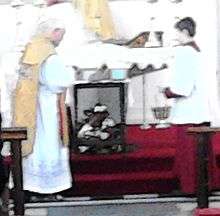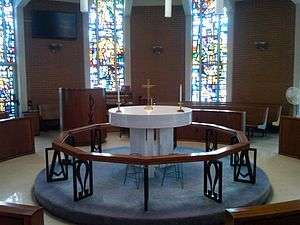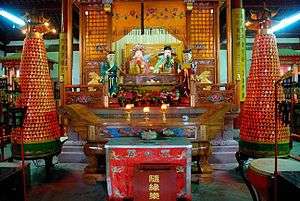Altar candle

Altar candles are candles set on or near altars for religious ceremonies. Various denominations have regulations or traditions regarding the number and type of candles used, and when they are lit or extinguished during the services.
Altar candles may sit directly on the altar or be placed in tall stands to the side of or behind the altar. For safety, altar candles are secured in some type of candle holder which may be simple or elaborate. To prevent wax from dripping, candles are often topped by a "candle follower", a short tube made of brass, glass or some other non-flammable material.
Christianity
Roman Catholic Church
In the Roman Rite of the Catholic Church, candles are required to be placed on or beside the altar, at least for the celebration of Mass. For reasons of religious tradition, the Church used the candles at divine service that are made of beeswax.[1]
Symbolism
To the three elements of a lit altar candle, some writers attached a symbolism related to Jesus Christ: the beeswax or other material symbolizing his body, the wick his soul, and the flame his divinity.
Also, the symbolism of prayer has been connected with candles; the burning flame of the candle represents the prayer that rises to God.
Regulation
For celebration of Mass, it is required that "on or next to the altar are to be placed candlesticks with lighted candles: at least two in any celebration, or even four or six, especially for a Sunday Mass or a holy day of obligation. If the Diocesan Bishop celebrates, then seven candles should be used, except if he is outside the boundary of his jurisdiction".[2]

At the beginning of the 20th century, complex rules governed the composition and number of candles to be used at Mass.[3] Lighted candles of the correct composition (beeswax, with no more than a minimal admixture of other material, and usually bleached) were considered so essential that, if before the consecration they happened to go out (quenched, for instance, by a gust of wind) and could not be relit within fifteen minutes, the celebration of Mass had to be abandoned, and some writers maintained that even if the candles could be relit within that time, Mass should in any case be begun again from the start. Some of these rules were formulated only in the second half of the nineteenth and the beginning of the 20th century.[3] The Roman Missal of the time continued to indicate merely that on the altar there should be "at least two candlesticks with lit candles" with a centrally placed cross between them (Rubricae generales Missalis, XX - De Praeparatione Altaris, et Ornamentorum eius). There is also a rule given in the same section of the Roman Missal - and still included even in the typical 1920 edition[4] - that "a candle to be lit at the elevation of the Sacrament" should be placed with the cruets of wine and water to the Epistle side of the altar.
Byzantine Rite
In the Byzantine Rite, either candles or oil lamps are prescribed for use on the Holy Table (altar). Traditionally, in the Eastern Orthodox Church, only pure beeswax candles may be offered in an Orthodox church. These may be plain or bleached—in some places, bleached beeswax candles are reserved for the Paschal season (Easter).
There will often be a matched pair of candlesticks to either side of the tabernacle, which are lit at any time the Holy Doors in the Iconostasis are opened. In the Slavic practice, these candlesticks usually hold a single large candle; in the Greek practice, these may be five-branch candlesticks. Additionally, in the Slavic practice, there is usually a large seven-branch candlestick directly behind the Holy Table.
A Sanctuary lamp (usually oil, but sometimes wax) will also be placed either on the Holy Table, or suspended above it. Traditionally, this lamp should be kept burning perpetually.
In the Eastern Catholic Churches and some Eastern Orthodox Churches, a lit candle is placed on a stand to the side of the Holy Table around the time of the Epiklesis.
Other Christian Churches
Candles are also placed on the altar in other liturgical rites of other Christian Churches.
Lutheranism
Arthur Carl Piepkorn, in a liturgical directory entitled “The Conduct of the Service,” stated that the normal Lutheran practice was to use two candles on the altar:
It is proper to light the altar candles for all services. The Lutheran use is to have two single beeswax candles, set near the extremities of the altar, either on the gradine or as close as possible to the back of the mensa, if there be no gradine. Six candles is a Counter-Reformatory Roman use. Candelabra as substitutes for the two single candles are a Protestant sentimentality. The Epistle candle is lighted first; the Gospel candle last; they are extinguished in reverse order. Lighting with a match held in the hand is not reverent:—extinguishing with puffs of breath from bloating cheeks is even less so. Use a lighter and snuffer. The lights may be lit by the officiant if there be no one to assist him, or by a choirboy, or by a server appointed for the purpose. In any case the individual performing this task should be decently vested. New candles should be started before the service, or they may cause embarrassing difficulties.[5]
Anglicanism
In Anglicanism, candles are used frequently in churches. Percy Dearmer, author of The Parson's Handbook, states that English use supports no more than two lights on the altar.
The use of a row of six candlesticks on the altar, or on a shelf or gradine behind it, is pure Romanism, and a defiance of the Ornaments Rubric, as of all other authority in the Church of England. From the beginning of the thirteenth century to the end of the nineteenth every declaration on the subject has mentioned the two lights on the altar only, and to this ancient and universal use of two lights, at the most, every known representation bears witness. Any one within reach of a large picture-gallery can verify this for himself; in the National Gallery, for instance, there are many illustrations of great interest in the Flemish, German, and Italian rooms and among the drawings of the Arundel collection. The evidence of the inventories, directories, &c., is practically the same. Now the instinct which led the church in the great ages of architecture and craftsmanship to use altar lights in this way was a true one; for an altar with two candlesticks upon it is more majestic and more beautiful than an altar with more than two. Furthermore, a row of candles hides the reredos or upper frontal, which ought to be one of the richest and most lovely things in the church. . . .[6]
He points out, however, that English and north European sanctions the use of other candles near the altar, e.g., there were "very often two Standards on the pavement"[7] and "one very beautiful method was to have sconces for candles on the top of the four poles that sometimes stood at the four corners of the altar to carry the riddels."[8] He concludes:
A church may therefore have (1) two lights on the altar; (2) two standards on the pavement, or four if the sanctuary is large enough (as is seldom the case) for their comely arrangement without overcrowding; (3) other lights near but not behind the altar (preferably two or four on the rods or pillars for the riddels) for use on the principal feasts; (4) others hanging from the roof in candelabra."[8]
Methodism

Methodist churches typically use (normally two) candles in a manner similar to the Anglican way.
Many congregations use two candles on the altar to point out that Jesus was both a human being and God. At the end of the service, the light is carried out into the world to show that Jesus Christ is for all people everywhere…The acolyte leaves the worship service at the pastor’s direction, carrying out the lighted candlelighter. This symbolizes the light of Jesus Christ going out into the world where believers are to serve.[9]
Other religions
Taoism
In the Taoist religion, a central lamp on the altar represents the Tao, while two candles to the left and right of it represent the Yin and Yang respectively. [10]

See also
References
- ↑ "Catholic Encyclopedia". New Advent.
- ↑ "Celebrating the Different Forms of Mass – Mass with a Congregation (article 117)". General Instruction of the Roman Missal (PDF). Catholic Truth Society. April 2005. ISBN 1 86082 288 6. Archived from the original (PDF) on 6 February 2007. Retrieved 2007-02-13.
- 1 2 Schulte, A.J. (1907). "Altar Candles". The Catholic Encyclopedia. 1. New York: Robert Appleton Company. Archived from the original on 13 February 2007. Retrieved 2007-02-13.
- ↑ "Missale Romanum" (PDF). 1920-07-25. Archived (PDF) from the original on 2006-11-05. Retrieved 2007-02-13.
- ↑ The Rev. Dr. Arthur Carl Piepkorn, “The Conduct of the Service,” CSPS 1965 (Revised Edition)
- ↑ Percy Dearmer, The Parson's Handbook (1907 ed.), pp. 96–97.
- ↑ Percy Dearmer, The Parson's Handbook (1907 ed.), p. 99.
- 1 2 Percy Dearmer, The Parson's Handbook (1907 ed.), p. 100.
- ↑ E. Byron Anderson, ed. (1999). Worship matters : a United Methodist guide to ways to worship. Nashville, Tenn.: Discipleship Resources. ISBN 978-0881772807.
- ↑ http://taoism.about.com/od/baibaithetaoistaltar/a/baibai.htm
External links
- Altar Candles article from The Catholic Encyclopedia
- Church Candles since 1874 Britain's most prestigious candle maker